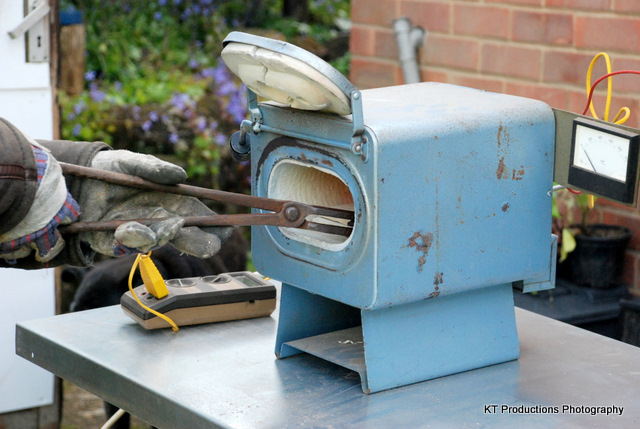Hello,
The blade of my Stanley low angle block plane is approaching the end of its life (I have bought it in 1993, so it has taken me a decade to use it up). I decided to make the replacement blade myself.
Today I have made the blade. I cut it from a piece of flat rolled tool steel sheet. The steel is unhardened, but the rolling process work-hardened it quite a bit, so cutting out the blank has been a hard work, even with a bi-metal blade in a metal-cutting frame saw. After cutting the strip, I have annealed the steel with a gas soldering lamp: I heated the steel to orange red and left it to cool slowly. Then I have flattened the blank with a small hammer on my Record anvil. I filed up the edges and drew the cut lines on the steel (I used the original blade as a template for mark-out). Then I drilled a few starting holes on my bench-top drill-press, with an 1,8 mm dia HSS twist drill. I used a jeweller's piercing saw and no.1 metal cutting blades for cutting out the openings. Then I filed the edges up to size and shape.
It has taken about four hours to make. Now I should harden and temper it, but do not have suitable oil at hand, so I must postpone this step. I will inform you about the results.
The new blade is approximately 2,5 millimetres thick (the stock was 2,6 millimetres nominal thickness, but the flattening reduced that somewhat), the original Stanley blade is 2,0 millimetres thick. I will see whether thicker is better, or not :wink:


The steel I use is No. 1770 (C = 0.7%, Si = 0.4%, Mn = 0.7%, P < 0.035%, S < 0.05%)
Have a nice day,
János
The blade of my Stanley low angle block plane is approaching the end of its life (I have bought it in 1993, so it has taken me a decade to use it up). I decided to make the replacement blade myself.
Today I have made the blade. I cut it from a piece of flat rolled tool steel sheet. The steel is unhardened, but the rolling process work-hardened it quite a bit, so cutting out the blank has been a hard work, even with a bi-metal blade in a metal-cutting frame saw. After cutting the strip, I have annealed the steel with a gas soldering lamp: I heated the steel to orange red and left it to cool slowly. Then I have flattened the blank with a small hammer on my Record anvil. I filed up the edges and drew the cut lines on the steel (I used the original blade as a template for mark-out). Then I drilled a few starting holes on my bench-top drill-press, with an 1,8 mm dia HSS twist drill. I used a jeweller's piercing saw and no.1 metal cutting blades for cutting out the openings. Then I filed the edges up to size and shape.
It has taken about four hours to make. Now I should harden and temper it, but do not have suitable oil at hand, so I must postpone this step. I will inform you about the results.
The new blade is approximately 2,5 millimetres thick (the stock was 2,6 millimetres nominal thickness, but the flattening reduced that somewhat), the original Stanley blade is 2,0 millimetres thick. I will see whether thicker is better, or not :wink:


The steel I use is No. 1770 (C = 0.7%, Si = 0.4%, Mn = 0.7%, P < 0.035%, S < 0.05%)
Have a nice day,
János
























